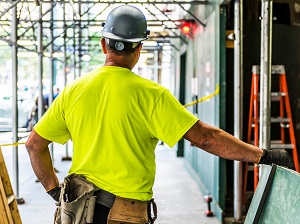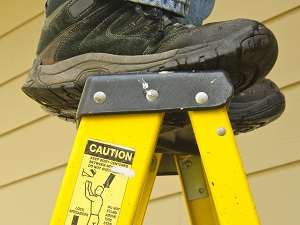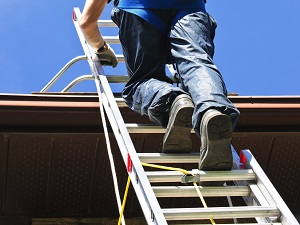Workers must be trained in ladder safety and must follow safe ladder use guidelines every time they use a portable ladder on the job.

Hazards to look out for and prevent when using portable ladders:
- Using a damaged ladder
- Placing a ladder on an unstable or slippery surface
- Slippery substances on worker’s shoes or ladder rungs/steps
- Climbing up or down in an unsafe manner
- Using a ladder for a purpose for which it was not designed
- Poor housekeeping near the ladder
- Setting up a ladder for use in a high-traffic area
- Close proximity to electrical wiring, equipment, or power lines
Always inspect every portable ladder before using it. If the ladder is damaged, it must be removed from service and tagged until it has been repaired or properly discarded. Never use a damaged ladder!
OSHA Standard 1926.1053(b)(15) Ladders shall be inspected by a competent person for visible defects on a periodic basis and after any occurrence that could affect their safe use.
Follow all manufacturer’s warnings for the specific type of ladder being used. If improperly used, portable ladders can lead to serious injuries or even fatal incidents.

Before climbing a ladder, think about where and how it will be set up. Read and follow all the instructions and warnings on the ladder.
Only put ladders on stable and level surfaces unless the base of the ladder is secured to prevent accidental movement. Never place a ladder on other objects, like boxes, shelving, scaffolds, or pallets, to try to gain more height to access the work area.
When it is necessary to set up a ladder in an area like a passageway, doorway, or driveway, the ladder should be secured, and the area should be barricaded to keep traffic and pedestrians away from the ladder to avoid displacement.
OSHA Standard 1910.23(c)(7) The employer must ensure that ladders placed in locations such as passageways, doorways, or driveways where they can be displaced by other activities or traffic are secured to prevent accidental displacement or are guarded by a temporary barricade, such as a row of traffic cones or caution tape, to keep the activities or traffic away from the ladder.
Maintain good housekeeping in the areas near ladders in use.
Ensure extension ladders are placed at a proper angle before climbing up and when in use. For every four feet high, the base of the extension ladder should be one foot out away from the wall. For example: If the ladder is 20 feet high the base should be moved away from the wall or other sturdy structure by 5 feet.

Employees must be trained on safe ladder use before use to prevent falls.
Keep ladders free of any slippery materials. Always check your shoes before stepping onto a ladder to make sure the soles are free from grease, oil, mud, or anything else that might cause slipping.
All workers using a ladder must face the ladder when climbing up and down and maintain 3-point contact (two hands and a foot, or two feet and a hand). Use at least one hand to grasp the ladder when climbing.
OSHA Standard 1926.1053(b)(21) Each employee shall use at least one hand to grasp the ladder when progressing up and/or down the ladder.
Do not carry objects or loads while climbing a ladder that could cause loss of balance.
Avoid overreaching while on a ladder. If the work requires overreaching or precarious balancing, then the ladder should either be moved, a different ladder should be chosen that is more suitable for the task, or an alternate way of completing the task should be determined.
Do not stand on the top step (top cap) of a stepladder or on the top three rungs of an extension ladder.
Never attempt to move the ladder without first descending, relocating the ladder, and then re-climbing. Do not move or shift a ladder while a person or equipment is on the ladder.

Always look for the rating of the ladder on the stickers and warning labels of the specific ladder used. Never exceed the ladder’s maximum load rating. To determine the correct ladder to use, consider your weight plus the weight of your load including all tools, materials, and equipment.
Only use the ladder in the manner it which it was designed to be used safely. Do not use a step ladder in a partially open position. The base must be spread fully open with the spreaders locked. Do not use a folded step ladder as an extension ladder.
OSHA Standard 1910.23(b)(8) The employer must ensure ladders are used only for the purposes for which they were designed.
Allow at least 3 feet (36 inches) of an extension ladder to extend above the edge or point of support when used to reach another surface.
Do not leave tools, materials, or equipment on a step ladder when the ladder is not in use. It is very easy to forget about them and when the ladder is shifted the tools can quickly become falling object hazards.
To prevent back injuries, avoid overreaching or twisting your body when lifting a ladder.
Avoid electrical hazards! Look for overhead power lines before handling or climbing a ladder. Do not use a metal ladder near power lines or electrical equipment.

.jpg)

